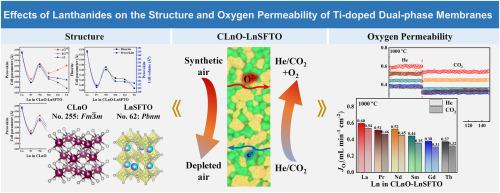镧系元素对掺钛双相膜的结构和氧气渗透性的影响
IF 8.4
1区 工程技术
Q1 ENGINEERING, CHEMICAL
引用次数: 0
摘要
在含有二氧化碳的工作环境中,氧传输膜(OTMs)的透氧性和稳定性之间仍然存在权衡效应。在此,我们在已报道的高稳定性掺钛 CPrO-PrSFTO 的基础上,通过选择不同的 Ln 元素,报道了一系列新的 60 wt%Ce0.9Ln0.1O2-δ-40 wt%Ln0.6Sr0.4Fe0.9Ti0.1O3-δ (CLnO-LnSFTO,Ln = La、Pr、Nd、Sm、Gd、Tb)双相 OTMs。系统研究了不同 Ln 元素对掺 Ti- 的双相 OTM 结构和透氧性的影响。基本上,随着镧元素原子序数的增加,萤石相和包晶石相的单胞参数都会变小。透辉石相的单胞体积和空间对称性减小,导致氧气透过率降低。最佳的 CLaO-LaSFTO 在 He 和 CO2 于 1000 °C 下扫频时的 JO2 分别为 0.60 和 0.54 mL min-1 cm-2。此外,所有 CLnO-LnSFTO OTM 在二氧化碳气氛中都能工作 100 小时以上,性能没有明显下降,保持了极佳的稳定性。这项研究探索了用于二氧化碳捕获和氧气分离的候选 OTM 材料,并为解决权衡效应提供了一些思路。本文章由计算机程序翻译,如有差异,请以英文原文为准。

Effects of lanthanides on the structure and oxygen permeability of Ti-doped dual-phase membranes
The trade-off effect of the oxygen permeability and stability of oxygen transport membranes (OTMs) still exists in working atmospheres containing CO2. Herein, we reported a new series of 60 wt%Ce0.9Ln0.1O2-δ-40 wt%Ln0.6Sr0.4Fe0.9Ti0.1O3-δ (CLnO-LnSFTO, Ln = La, Pr, Nd, Sm, Gd, Tb) dual-phase OTMs by selecting different Ln elements based on the reported highly stable Ti-doped CPrO-PrSFTO. The effects of different Ln elements on the structure and oxygen permeability of Ti-doped dual-phase OTMs were systematically studied. Basically, as the atomic number of Ln elements increases, the unit cell parameters of both the fluorite phase and the perovskite phase become smaller. The unit cell volume and spatial symmetry of the perovskite phase are reduced, resulting in a reduction in oxygen permeability. The optimal CLaO-LaSFTO showed of 0.60 and 0.54 mL min−1 cm−2 with He and CO2 sweeping at 1000 °C, respectively. In addition, all CLnO-LnSFTO OTMs could work for more than 100 h with no significant performance degradation in a CO2 atmosphere, maintaining excellent stability. This work explores candidate OTM materials for CO2 capture and oxygen separation, as well as provides some ideas for addressing the trade-off effect.
求助全文
通过发布文献求助,成功后即可免费获取论文全文。
去求助
来源期刊

Journal of Membrane Science
工程技术-高分子科学
CiteScore
17.10
自引率
17.90%
发文量
1031
审稿时长
2.5 months
期刊介绍:
The Journal of Membrane Science is a publication that focuses on membrane systems and is aimed at academic and industrial chemists, chemical engineers, materials scientists, and membranologists. It publishes original research and reviews on various aspects of membrane transport, membrane formation/structure, fouling, module/process design, and processes/applications. The journal primarily focuses on the structure, function, and performance of non-biological membranes but also includes papers that relate to biological membranes. The Journal of Membrane Science publishes Full Text Papers, State-of-the-Art Reviews, Letters to the Editor, and Perspectives.
 求助内容:
求助内容: 应助结果提醒方式:
应助结果提醒方式:


